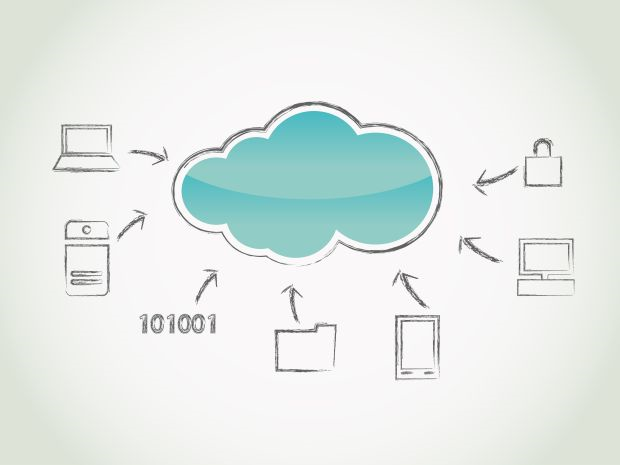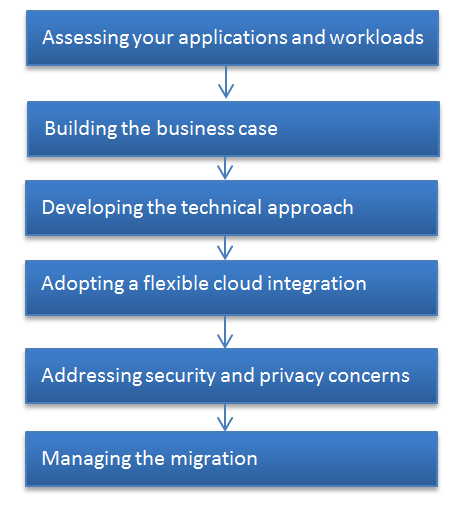How to migrate Your Data and Application to the Cloud

Audio : Listen to This Blog.

Cloud computing is intended to reduce the expenses of IT organizations by lowering capital expenditure by allowing them to purchase only the required amount of computing and storage resources. Today, due to the enormous advantages of cloud computing, many organizations are exploring how the cloud could be leveraged to make their enterprise applications available on an on-demand basis.
In the last few years, thousands of companies moved to the cloud, through public, private, or hybrid cloud offerings. Many others are considering moving to the cloud due to its enormous advantages.
Before you move to the cloud, it is important to look at the major advantages of cloud computing.
When it comes to migration to the cloud, you can take advantage of Microsoft’s Windows Azure, Google Cloud, Amazon AWS, Citrix, etc. Companies use these platforms to build websites, web apps, mobile apps, media solutions, etc.
Migrating to the cloud, you can potentially create more business profits by taking risks and encouraging experimentation. While risk taking in the past requires you to invest a lot in hardware and software, the cloud allows you to create an application on a completely scalable platform and get it out in the form of a service rather than selling licenses.
Although these advantages are there, migration may not be an easy task. For instance, enterprise applications are faced with strict requirements in terms of performance, service uptime, etc. Migrating them to the cloud requires you to analyze all these requirements very closely and come up with an in-depth migration plan that increases ROI.
Hardware resources required can be greatly minimized by cloud migration. Since pooled resources are better utilized, moving to the public cloud can dramatically decrease the need for in-house servers. This will also reduce physical floor space and power consumption. In addition, as mentioned above, migration will surely reduce operational and management costs. A number of solution and service providers in the cloud market can help you easily migrate at reduced cost structure. MSys has also been providing the same type of migration service for years.
Things to Check before Cloud Migration
An important thing to consider while migrating to the cloud is analyzing the changes required in the architecture of the application being migrated. In many cases, the application must undergo a complete architecture change to be fit for the cloud. A service-oriented application works well with the abstraction of cloud services through application programming interfaces (APIs). Additionally, you should also seek whether the application needs to be altered to take advantage of the native cloud features. Direct access to elastic storage, management of interfaces, and auto-provisioning services are some of these cloud features you may want to take advantage of.
Migration Roadmap
During the transition, you should also ensure that the level of service provided in the cloud is comparable or better than the service provided by traditional technical environments. Failure to comply with this requirement is the result of improper migration to the cloud. And it will result in higher costs, loss of business, etc., thus eliminating any benefits that the cloud could provide. A few steps involved in the migration of an application to the cloud include:

1. Assessing Your Applications and Workloads
This step allows organizations to find out what data and applications can be readily moved to the cloud. During this phase, you can also determine the delivery models supported by each application. It of course makes sense to sort the applications to be ported based on the risk factor, especially the ones with minimal amount of customer data or other sensitive information.
2. Build a Business Case
Building a business case requires you to come up with a proper migration strategy for porting your applications and data to the cloud. This strategy should incorporate ways to reduce costs, demonstrates advantages, and deliver meaningful business value. Value propositions of cloud migration include shift of capital expenditures to operational expenditures, cost savings, faster deployment, elasticity, etc.
3. Develop a Technical Approach
There are two potential service models to migrate an existing application—Infrastructure as a Service (IaaS) and Platform as a Service (PaaS). For PaaS migration, the application itself has to be designed for the runtimes available in the target PaaS. However, for IaaS, the requirements are not that much.
4. Adopt a Flexible Integration Model
An application that gets migrated to the cloud might have already existing connections with other applications, services, and data. It is important to understand the impact of these connections before proper migration to the cloud. The integration model to be adopted may involve three types: process integration (an application invokes another application to execute a workflow), data integration (integration of the data shared among applications), and presentation integration (multiple applications sharing results over a single dashboard).
5. Address Security and Privacy Requirements
Two of the most important issues faced in migration to the cloud are security and privacy issues. Especially in the case of applications that deal with sensitive information, such as credit card numbers and social security information, the security should be high. Several issues to be addressed are there, including the difficulty for an intruder to steal any data, proper notifications on security breach, reliability of the personnel of the cloud service provider, authorization issues, etc.
6. Manage the Migration
After thoroughly analyzing the various benefits and issues associated with migration, planning and execution of the migration can happen. It should be done in a controlled manner with the help of a formal migration plan that tracks durations, resources, costs, and risks.
MSys Technologies’ Cloud Expertise
In cloud migration, we have industry-wide expertise in SaaS, PaaS, IaaS. In IaaS, we have worked on private and public clouds with infrastructures such as OpenStack, Amazon AWS, Windows Azure, Rackspace, VMware, Cloupia, HP Cloud, etc.
Clogeny, MSys’s subsidiary company, has worked on hybrid cloud migration projects for leading clients in server imaging and datacenter provisioning. We have helped add support for several public vCloud Director implementations, including Bluelock, AT&T, Savvis, and Dell. In addition, we have architected hybrid cloud migration appliance for VMware vSphere. In enterprise Java PaaS, we have worked on VMware vCloud Director, AWS, HP Cloud, and Rackspace.
Conclusion
Cloud computing provides a few key benefits for companies. Migration to the cloud may create a better, modern business model for most tech companies.
